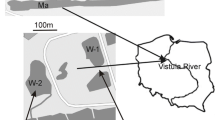Abstract
Studies on phosphorus regeneration by zooplankton occupying the Krutynia River - lake Kujno transitory zone showed the zone to consist of three parts. In the first one, under strong impact of river waters, P regeneration rate was low and dominated by small, pelagic rotifers. Species diversity index calculated for phosphorus regeneration was also low. In the second part, densely covered with macrophytes, the role of large-bodied littoral zooplankton in P regeneration became more important and the rate of the process and species diversity index markedly higher. The third part, a type of littoral-pelagic belt, was characterized by the highest P regeneration and species diversity index and a relatively higher contribution of pelagic forms of zooplankton to the process of phosphorus regeneration.
Similar content being viewed by others
References
Barlow, J. P. & J. W. Bishop, 1965. Phosphate regeneration by zooplankton in Cayuga Lake. Limnol. Oceanogr. 10 (suppl.): 15–24.
Bottrell, H. H., A. Duncan, Z. M. Gliwicz, E. Grygierek, A. Herzig, A. Hillbricht-Ilkowska, H. Kurasawa, P. Larrson & T. Węgleńska, 1986. A review of some problems in zooplankton production studies. Norw. J. Zool. 24: 419–456.
Devol, A. H., 1979. Zooplankton respiration and its relation to plankton dynamics of two lakes of contrasting trophic state. Limnol. Oceanogr. 24: 893–905.
Ejsmont-Karabin, J., 1984. Phosphorus and nitrogen excretion by lake zooplankton (rotifers and crustaceans) in relationship to individual body weights of the animals, ambient temperature and presence or absence of food. Ekol. pol. 32: 3–42.
Ejsmont-Karabin, J., L. Bownik-Dylińska & W. A. Godlewska-Lipowa, 1983. Biotic structure and processes in the lake system of R. Jorka Watershed (Masurian Lakeland, Poland). VII. Phophorus and nitrogen regeneration by zooplankton as the mechanism of the nutrient supplying for bacterio- and phytoplankton. Ekol. pol. 31: 719–746.
Ejsmont-Karabin, J. & T. Węgleńska, 1989. Densities, structure and the role of zooplankton in phosphorus cycling in limnetic and lotic parts of Zegrzyński Reservoir. Ekol. pol. 37:251–280.
Hargrave, B. T. & G. H. Green, 1968. Phosphorus excretion by zooplankton. Limnol. Oceanogr. 13: 332–343.
Hillbricht-Ilkowska, A., 1993. The dynamics and retention of phosphorus in lentic and lotic patches of two river-lake systems. In A. Hillbricht-Ilkowska & E. Pieczyńska (eds), Nutrient Dynamics and Retention in Land/Water Ecotones of Lowland, Temperate Lakes and Rivers. Developments in Hydrobiology 82. Kluwer Academic Publishers, Dordrecht: 257–268. Reprinted from Hydrobiologia 251.
Kairesalo, T. & T. Sepälä, 1987. Phosphorus flux through a littoral ecosystem: the importance of cladoceran zooplankton and young fish. Int. Revue ges. Hydrobiol. 72: 385–403.
Korstad, J., 1983. Nutrient regeneration by zooplankton in southern lake Huron. J. Great Lakes Res. 9: 374–388.
Kufel, L., 1993. Particulate phosphorus sedimentation at the river inflow to a lake. In A. Hillbricht-Ilkowska & E. Picczyńska (eds), Nutrient Dynamics and Retention in Land/Water Ecotones of Lowland, Temperate Lakes and Rivers. Developments in Hydrobiology 82. Kluwer Academic Publishers, Dordrecht: 269–274. Reprinted from Hydrobiologia 251.
Lodge, D. M., J. J. Barko, D. Strayer, J. M. Melack, G. G. Mittelbach, R. W. Howarth, B. Menge & J. E. Titus, 1988. Spatial heterogeneity and habitat interactions in lake communities. In: S. R. Carpenter (ed.), Complex interactions in lake communities, Springer-Verlag New York Inc.: 181–208.
MacArthur, R., 1955. Fluctuations in animal populations, and a measure of community stability. Ecology 36: 533–536.
Margalef, R., 1957. Information theory in ecology. Gen. Syst. 3: 36–71.
Riber, H. H., J. P. Sorensen & A. Kowalczewski, 1983. Exchange of phosphorus between water, macrophytes and epiphytic periphyton in the littoral of Mikolajskie Lake, Poland. In: R. G. Wetzel (ed.), Periphyton of Freshwater Ecosystems, Dr W. Junk Publishers, The Hague: 235–243.
Timms, R. M. & B. Moss, 1984. Prevention of growth of potentially dense phytoplankton populations by zooplankton grazing, in the presence of zooplanktonivorous fish, in a freshwater wetland ecosystem. Limnol. Oceanogr. 29: 472–486.
Whittaker, R. H. & C. W. Fairbanks, 1958. A study of plankton copepod communities in the Columbia Basin, Southeastern Washington. Ecology 39: 46–65.
Zurek, R., 1982. Effect of suspended materials on zooplankton. 2. Laboratory investigations of Daphnia hyalina Leydig. Acta Hydrobiol. 24: 233–251.
Author information
Authors and Affiliations
Rights and permissions
About this article
Cite this article
Ejsmont-Karabin, J., Królikowska, J. & Węgleńska, T. Patterns of spatial distribution of phosphorus regeneration by zooplankton in a river-lake transitory zone. Hydrobiologia 251, 275–284 (1993). https://doi.org/10.1007/BF00007187
Issue Date:
DOI: https://doi.org/10.1007/BF00007187




